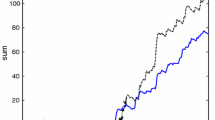Abstract
In the recent years, spectrum scarcity becomes an urgent issue due to the emergence of wireless services. The effective utilization of spectrum white space has gained significant research interests. Cognitive radio techniques have been paid much attention to the television white space. This paper raises a multiband spectrum sensing scheme to detect the spectrum white space which is not limited to television bands. When performing spectrum sensing, our approach operates over the total frequency bands simultaneously rather than a single band each time. By applying the idea of multistage Wiener filter to Gerschgorin disk estimator, our approach jointly makes the decision. In this way, the proposed method is able to capture the signal information and suppress the additive noise, which brings about an enhanced detection performance. Distinct from the classical methods, the proposed scheme requires neither noise power estimation nor prior knowledge of primary user signal, thereby being robust to noise uncertainty and suitable for blind detection. On the contrary, in the context of noise uncertainty, noise variance has no access to accurate estimation, inducing an imprecise decision threshold, which severely deteriorates the detection performance. Besides, our method avoids the estimation of covariance matrix as well as eigenvalue decomposition, and thus achieves a low computational complexity. This paper presents simulations under various conditions to verify the performance of the proposed scheme and the results show that it is superior to the existing sensing algorithms.






Similar content being viewed by others
References
Haykin, S. (2005). Cognitive radio: Brain-empowered wireless communications. IEEE Journal on Selected Areas in Communications, 23(2), 201–220.
Maharjan, S., Zhang, Y., & Gjessing, S. (2011). Economic approaches for cognitive radio networks: A survey. Wireless Personal Communications, 57(1), 33–51.
Gavrilovska, L., & Atanasovski, V. (2011). Spectrum sensing framework for cognitive radio networks. Wireless Personal Communications, 59(3), 447–469.
Yucek, T., & Arslan, H. (2009). A survey of spectrum sensing algorithms for cognitive radio applications. IEEE Communications Surveys and Tutorials, 11(1), 116–130.
Rif-Pous, H., Blasco, M. J., & Garrigues, C. (2012). Review of robust cooperative spectrum sensing techniques for cognitive radio networks. Wireless Personal Communications, 67(2), 175–198.
Jiao, L. C., Chen, J., Wu, J., Wang, X., & Zhang, S. (2012). Efficient collaborative spectrum sensing with low sample rate. Wireless Personal Communications, 67(4), 923–936.
Urkowitz, H. (1967). Energy detection of unknown deterministic signals. Proceedings of the IEEE, 55(4), 523–531.
Tandra, R., & Sahai, A. (2008). SNR walls for signal detection. IEEE Journal of Selected Topics in Siginal Processing, 2(1), 4–17.
Zeng, Y., & Liang, Y. C. (2009). Eigenvalue-based spectrum sensing algorithms for cognitive radio. IEEE Transactions on Communications, 57(6), 1784–1793.
Zeng, Y., Liang, Y. C., & Zhang, R. (2008). Blindly combined energy detection for spectrum sensing in cognitive radio. IEEE Signal Processing Letters, 15, 649–652.
Zhang, R., Lim, T. J., Liang, Y. C., & Zeng, Y. (2010). Multi-antenna based spectrum sensing for cognitive radios: A GLRT approach. IEEE Transactions on Communications, 58(1), 84–88.
Taherpour, A., Gazor, S., & Nasiri-Kenari, M. (2009). Invariant wideband spectrum sensing under unknown variances. IEEE Transactions on Wireless Communications, 8(5), 2182–2186.
Qing, H., Liu, Y., & Xie, G. (2014). Smart antennas aided wideband detection for spectrum sensing in cognitive radio networks. Electronics Letters, 50(7), 490–492.
Qing, H., Liu, Y., Xie, G., Liu, K., & Liu, F. (2014). Blind multiband spectrum sensing for cognitive radio systems with smart antennas. IET Communications, 8(6), 914–920.
Quan, Z., Cui, S., Sayed, A. H., & Poor, H. V. (2009). Optimal multiband joint detection for spectrum sensing in cognitive radio networks. IEEE Transactions on Signal Processing, 57(3), 1128–1140.
Wax, M., & Kailath, T. (1985). Detection of signals by information theoretic criteria. IEEE Transactions on Acoustics, Speech, and Signal Processing, 33(2), 387–392.
Wu, H. T., Yang, J. F., & Chen, F. K. (1995). Source number estimators using transformed Gerschgorin radii. IEEE Transactions on Signal Processing, 43(6), 1325–1333.
Huang, L., Long, T., & Wu, S. (2008). Source enumeration for high-resolution array processing using improved Gerschgorin radii without eigendecomposition. IEEE Transactions on Signal Processing, 56(12), 5916–5925.
Johnson, D. H., & Dudgeon, D. E. (1993). Array signal processing: Concepts and techniques. Englewood Cliffs, NJ: Prentice-Hall.
Wilkinson, J. H. (1998). The algebraic eigenvalues problem. Oxford: Oxford University Press.
Goldstein, J. S., Reed, I. S., & Scharf, L. L. (1998). A multistage representation of the Wiener filter based on orthogonal projections. IEEE Transactions on Information Theory, 44(7), 2943–2959.
You, Z., Li, X., & Liu, D. (1998). Study on the source number estimator using Gerschgorin radii. In Proceedings of the 4th international conference on signal processing (ICSP), Beijing, China, pp. 152–155.
Acknowledgments
This work was supported in part by the National High Technology Research and Development Program (863 Program) of China, the National Natural Science Foundation of China (Grant Nos. 61302083 and 61327806), Important National Science and Technology Specific Projects of China (Grant No. 2012ZX03003001-004) and Beijing Higher Education Young Elite Teacher Project.
Author information
Authors and Affiliations
Corresponding author
Rights and permissions
About this article
Cite this article
Qing, H., Liu, Y., Xie, G. et al. Multiband Detection for Spectrum Sensing: A Multistage Wiener Filter Perspective. Wireless Pers Commun 81, 39–52 (2015). https://doi.org/10.1007/s11277-014-2116-1
Published:
Issue Date:
DOI: https://doi.org/10.1007/s11277-014-2116-1




